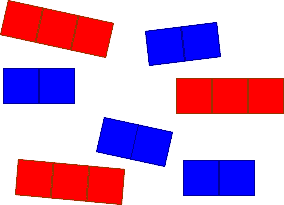Making sticks
Kimie and Sebastian were making sticks from interlocking cubes and lining them up. Can they make their lines the same length? Can they make any other lines?
Problem
Printable NRICH Roadshow resource
Kimie and Sebastian were making sticks from interlocking cubes. Kimie made blue sticks two cubes long. Sebastian made red sticks three cubes long. They both made a lot of sticks.

Kimie put her blue sticks end to end in a long line. Sebastian put his red sticks end to end in a line underneath Kimie's.
Can they make their lines the same length? How many sticks could Kimie use? How many would Sebastian put down? How long is the line altogether?
Can they make any other lines?
Getting Started
You could use cubes to make the sticks yourself, or draw the sticks on squared paper.
If you line up two blue sticks, can you make a line of red sticks which is the same length?
Try with three blue sticks - can you make a line of red sticks which is the same length?
What happens when you try four blue sticks? Five?
Student Solutions
Sarah, Evan, Lucas and Daniel from the Buchan School on the Isle of Man sent in the following explanation and picture of their work:
Yes they can make their lines be the same length if Kimie used three of her sticks and Sebastian used two of his sticks. Each of the sticks are 6 cubes long. If it is both lines together then that would make 12 cubes. If there are only the amount of sticks in the picture then no but if there more sticks then yes.

Rebecca in Colchester wrote:
Kimie needs three sticks, Sebastian needs two, the line is 6 altogether.
Other solutions are:
Kimi 6, Sebastian 4, Length 12
Kimi 9, Sebastian 6, Length 18
Kimi 12, Sebastian 8, Length 24
Alistair from Histon and Impington Infants School said:
Yes they can make their lines the same length. Kimie could use three sticks for Sebastian's two. They would both make a line six cubes long. They can make other lines the same length. These will be in the 6 times table.
That's a helpful observation about the lines always being in the 6 times table, Alistair.
Teachers' Resources
Why do this problem?
Possible approach
Key questions
Possible extension
Possible support
